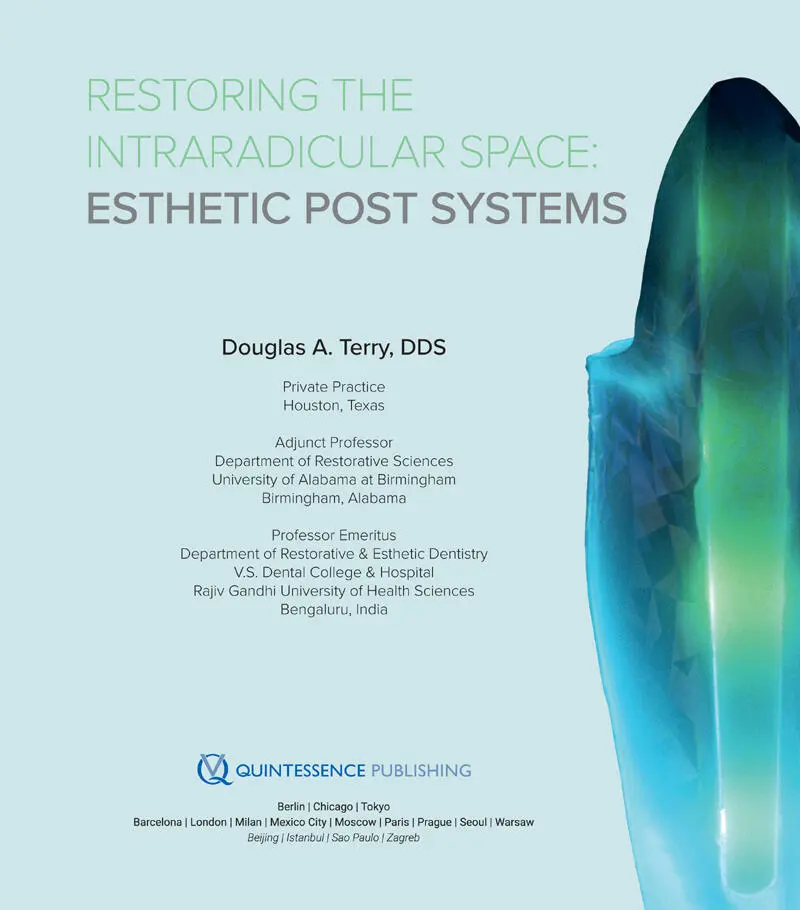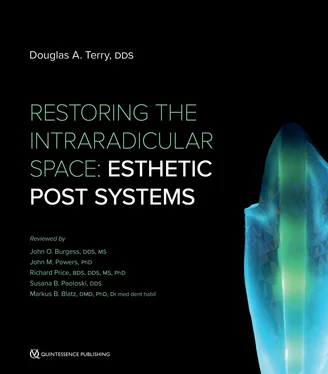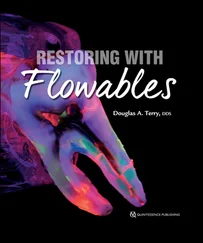RESTORING THE INTRARADICULAR SPACE: ESTHETIC POST SYSTEMS

Library of Congress Cataloging-in-Publication Data
Names: Terry, Douglas A., author.
Title: Restoring the intraradicular space : esthetic post systems / Douglas A. Terry.
Description: Batavia, IL : Quintessence Publishing Co, Inc, [2021] | Includes bibliographical references and index. | Summary: “This book describes the biologic basis for restoring weakened teeth with post and core systems, focusing on how to do this conservatively and esthetically to maximize longevity”-- Provided by publisher.
Identifiers: LCCN 2020050058 | ISBN 9781647240561 (hardcover)
Subjects: MESH: Post and Core Technique | Dental Restoration, Permanent | Esthetics, Dental | Root Canal Therapy
Classification: LCC RK652.5 | NLM WU 515 | DDC 617.6/95--dc23
LC record available at https://lccn.loc.gov/2020050058

©2021 Quintessence Publishing Co, Inc
Quintessence Publishing Co, Inc
411 N Raddant Road
Batavia, IL 60510
www.quintpub.com
5 4 3 2 1
All rights reserved. This book or any part thereof may not be reproduced, stored in a retrieval system, or transmitted in any form or by any means, electronic, mechanical, photocopying, or otherwise, without prior written permission of the publisher.
Editor: Leah Huffman
Design: Sue Zubek
Production: Sue Robinson
Printed in China
CONTENTS
Foreword
Preface
Contributors
1 | ESTHETIC POST SYSTEMS
2 | THE ADHESIVE DESIGN CONCEPT
3 | CLINICAL APPLICATIONS FOR RESTORING “COMPROMISED” ENDODONTICALLY TREATED TEETH
4 | CLINICAL APPLICATIONS FOR RESTORING “END STAGE” ENDODONTICALLY TREATED TEETH
Index

Scan this QR code to access additional scientific content.
FOREWORD

There is a question I always ask myself, my students, and my colleagues: “What is our single most important responsibility as an oral health care provider?” While there may be various interpretations of our core duties, I always come to the same simple but resounding answer: “To help our patients keep their teeth as long as possible!”
To pursue this goal and preserve teeth, we have to emerge from the era of destructive dentistry, which dates back to times before resin bonding and adhesive protocols were available. Healthy tooth structure had to be sacrificed during preparation to accommodate restorative and prosthetic materials that relied solely on retention. The popularity of implant dentistry sometimes added to this destructive mindset when teeth were extracted and implants placed too early or inadequately, thereby accelerating the cascade of early tooth loss instead of following the core principle of preservation. The rush to the seemingly easiest but most destructive treatment options may lead to early tooth loss, bone and tissue resorption, peri-implantitis, and altered eruption of teeth next to implants that were placed in younger patients.
Several new studies agree that the recommended age when dental implants can be placed safely is going up and up, making a strong case to preserve even severely damaged and endodontically treated teeth as long as possible. Don’t get me wrong: I have nothing against implants, and in many cases, they are the last and absolutely best resort to provide our patients with chewing function and esthetics. However, they are the last resort when everything else fails. And the argument I often hear that “implants last longer than teeth” is not only completely wrong but not even a logical argument for erring on the side of placing implants earlier instead of exploiting all resources to try and save a natural tooth. While some of that rationale may, sadly, be driven by convenience and economic aspects, I believe that the most important factors in the treatment-planning decision-making process are proper knowledge and information.
The most difficult treatment-planning decisions are related to the severely damaged endodontically treated tooth. The amount of misinformation on this topic is simply astonishing. What is the state of the scientific evidence on endodontically treated teeth and how to restore them? When should a post be placed? And in light of this era of minimally invasive and adhesive dentistry, what are the best materials and most current protocols for post and core placement, based on the science?
Douglas, author of many groundbreaking and bestselling books, has compiled a team of the most respected researchers and clinicians to answer these questions and provide clear guidance on a topic that seems to have been widely overlooked. Restoring the Intraradicular Space: Esthetic Post Systems provides a detailed and scientific description of the evolution of post and core systems while offering a comprehensive view into all associated aspects, from general design criteria and the components of the post and core systems to post materials, adhesive bonding and luting agents, material selection, core buildup, and finally, the extracoronal restoration. The dilemma of preserving or replacing the compromised natural tooth is discussed in great detail with ample scientific support. Over 1,000 cited research studies are distilled into clear and meaningful guidelines for the clinician to select an appropriate system for the restorative management of endodontically treated teeth for each clinical situation. In well-known Douglas Terry manner, clinical protocols are illustrated meticulously and with stunning quality with over 800 photographs and figures.
To fulfill our responsibility to help patients keep their teeth as long as possible, understanding and selecting proper protocols, materials, and procedures to restore endodontically treated teeth is indispensable. While a comprehensive text on this topic was long overdue, Restoring the Intraradicular Space: Esthetic Post Systems is not only an exceptional resource for the practicing dentist but a true masterpiece in its scientific rigor and clinical excellence. The captivating writing and superb clinical documentation make this an essential piece of literature for oral health care providers at any stage of their career. Congratulations Douglas and team—I am sure that your work will inspire countless colleagues and prevent many patients from losing their teeth too early. Thank you for that!

Markus B. Blatz, DMD, PhD, Dr med dent habil
Chairman, Department of Preventive and Restorative Sciences
Assistant Dean for Digital Technologies and Professional Development
University of Pennsylvania School of Dental Medicine
PREFACE

Recently I read a comment by a dentist saying “every root has a chance.” This statement resonated with my philosophy because it is not only the tooth but also the alveolar and soft tissue architecture and the patient that deserve a chance. Over the last decade I have witnessed patients presenting with fractured teeth that were referred for removal and implant placement. Upon discussion with them, it became clear that not everyone was given proper informed consent; some were offered only the one treatment option. So I would explain the how’s and why’s of every option, and then the patient could make the proper choice for their oral health. Individuals make better decisions when they are given all the potential options and the consequences of each.
Читать дальше


















